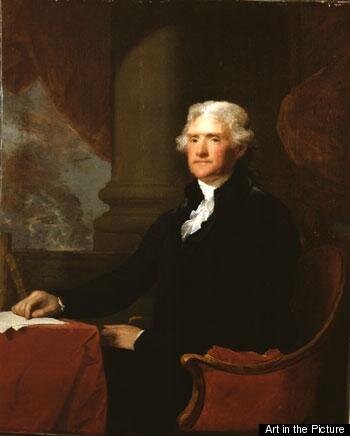
Jefferson's Monticello garden was a Revolutionary American garden. One wonders if anyone else had ever before assembled such a collection of vegetable novelties, culled from virtually every western culture known at the time, then disseminated by Jefferson with the persistence of a religious reformer, a seedy evangelist. Here grew the earth's melting pot of immigrant vegetables: an Ellis Island of introductions, the whole world of hardy economic plants: 330 varieties of eighty-nine species of vegetables and herbs, 170 varieties of the finest fruit varieties known at the time. The Jefferson legacy supporting small farmers, vegetable cuisine, and sustainable agriculture is poignantly topical today.
Thomas Jefferson liked to eat vegetables, which "constitute my principal diet," and his role in linking the garden with the kitchen into a cuisine defined as "half French, half Virginian" was a pioneering concept in the history of American food. The Monticello kitchen, as well as the table at the President's House in Washington, expressed a seething broil of new, culinary traditions based on these recent garden introductions: French fries, peanuts, Johnny-cakes, gumbo, mashed potatoes, sweet potato pudding, sesame seed oil, fried eggplant, perhaps such American icons as potato chips, tomato catsup, and pumpkin pie. The western traditions of gardening - in England, France, Spain, the Mediterranean - were blended into a dynamic and unique Monticello cookery through the influence of emerging colonial European, native American, slave, Creole and southwestern vegetables.
Jefferson, according to culinary historian Karen Hess, was "our most illustrious epicure, in fact, our only epicurean President," and his devotion to fresh produce, whether in the President's House at a state dinner, or at Monticello for the large numbers of celebrity tourists who crowded the retired President's table, remains a central legacy of Jefferson's gardening career. Jefferson also promoted commercial market gardening. The remarkable calendar he compiled while President, delineating the first and last appearance of thirty-seven vegetables in the Washington DC farmer's market, is among the most revelatory documents in the history of American food. As well, it was Jefferson himself who obtained new vegetable varieties from foreign consuls, passed them on to Washington market gardeners, and ordered his maitre 'd to pay the highest prices for the earliest produce.
In 1792 Jefferson, while serving as Secretary of State in Philadelphia, received a letter from his daughter, Martha, complaining about the insect-riddled plants in the Monticello Vegetable Garden. His response is a stirring anthem to the organic gardening movement. "We will try this winter to cover our garden with a heavy coating of manure. When is rich it bids defiance to droughts, yields in abundance, and of the best quality. I suspect that the insect which have harassed you have been encouraged by the feebleness of your plants; and that has been produced by the lean state of the soil." Jefferson's rallying cry on the remedial value of manure, the horticultural rewards of soil improvement, has inspired gardeners of all kinds.
Jefferson not only enjoyed the garden process and relished eating fresh produce, but the garden also functioned as an experimental laboratory, in some ways, as a vehicle for social change. He wrote that, "the greatest service which can be rendered any country is to add an useful plant to its culture," and Jefferson ranked the introduction of the olive tree and upland rice into the United States with his authorship of the Declaration of Independence.
A Johnny Appleseed of the vegetable world, Jefferson passed out seeds of his latest novelty with messiahinistic fervor: not only to friends and neighbors like George Divers and John Hartwell Cocke, his family of daughters, granddaughters, and sons in law, but to fellow politicians - from George Washington to James Madison -- and the leading plantsmen of the early nineteenth century like McMahon, William Bartram, William Hamiton of Philadelphia, and Andre Thouin of Paris. Although few species can be proven as Jefferson introductions into American gardens, the recitation of vegetables grown at Monticello is a meditative chant of rare, unusual, and pioneering species: asparagus bean, sea kale, tomatoes, rutabaga, lima beans, okra, potato pumpkins, winter melons, tree onion, peanuts, "sprout kale," serpentine cucumbers, cauliflower, broccoli, Brussells sprouts, orach, endive, peanuts, chick peas, cayenne pepper, "esculent Rhubarb," black salsify, sesame, eggplant.
Although a modest endeavor, Jefferson's only published horticultural work was "A General Gardening Calendar," a monthly guide to kitchen gardening that appeared in a May 21, 1824 edition of the American Farmer, a Baltimore periodical of progressive agriculture. Here Jefferson authoritatively instructed gardeners to plant a thimble spool of lettuce seed every Monday morning from February 1 to September 1, as if the Monday morning lettuce sowing was a life lesson or discipline akin to dutifully saying your prayers or cleaning one's dinner plate; the rites of Monday morning led to a long life, happiness, and good teeth.
Michelle Obama recently declared that the White House kitchen garden "has been one of the greatest things I've done in my life so far." An admirer of Thomas Jefferson and inspired by a visit to the Monticello garden, White House chef and Coordinator of the White House Food Initiative, Sam Kass, reserved a discrete section of this garden in honor of Thomas Jefferson. In the spring of 2009 it was planted with seeds and plants of Thomas Jefferson's favorite vegetable varieties: Tennis-ball and Brown Dutch lettuce, Prickly-seeded spinach and Marseilles fig. The Jefferson legacy in gardening and food is not a mere historical curiosity, but is a compelling force in the movement toward a more sustainable agricultural future.
This year's Heritage Harvest Festival will took place on September 11, 2010, and was held at Monticello for the first time, where the recently renovated dining room, wine cellar, and kitchen were open to the public. For more information please visit: www.heritageharvestfestival.com
Peter Hatch is the Director of Gardens and Grounds at the Thomas Jefferson Foundation.